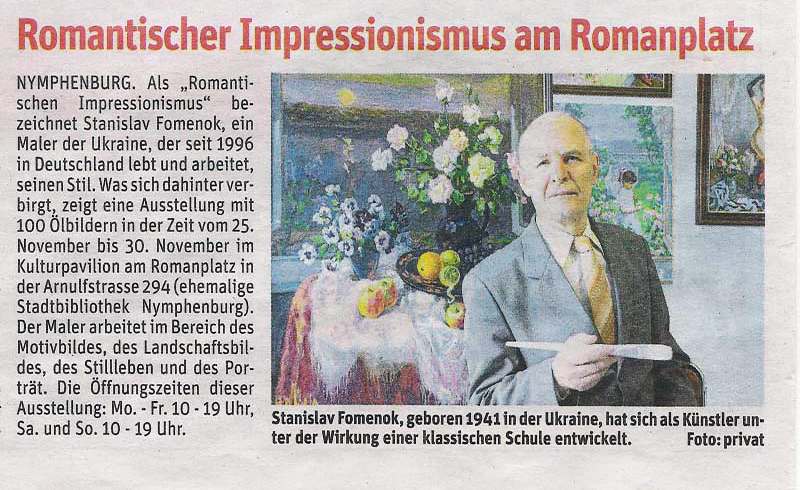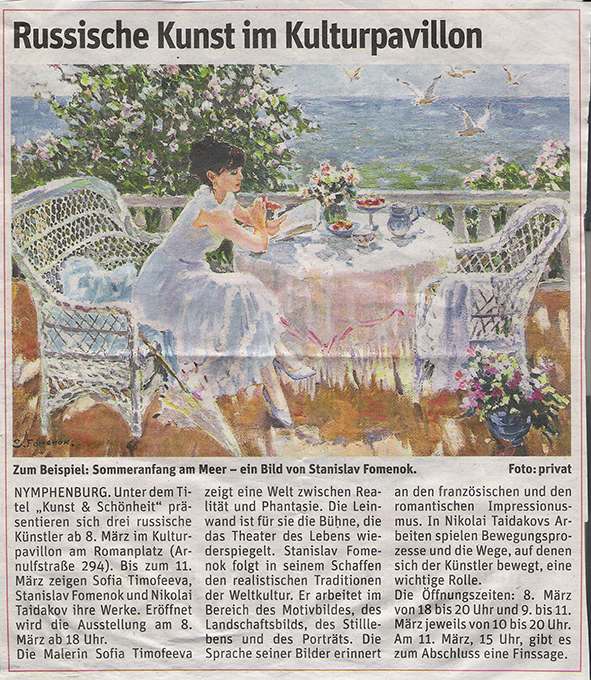Serhii Nesmachnyi, Art critic, Deputy Director of Research of the museum
 The exhibition is of pronounced retrospective character. There are 86 paintings exposed, which are quite fully represent the creative “image” of the author as a prominent disciple of the realistic method, and create a dimensional perception of two different worlds, reflected in the best samples of art of artistic maturity periods – the “Soviet” (1980) and “Munich” (1996 - 2010) ones.
The exhibition is of pronounced retrospective character. There are 86 paintings exposed, which are quite fully represent the creative “image” of the author as a prominent disciple of the realistic method, and create a dimensional perception of two different worlds, reflected in the best samples of art of artistic maturity periods – the “Soviet” (1980) and “Munich” (1996 - 2010) ones.
The “Time View” – the name for the exhibition, suggested by the author himself, which very clearly represents its content. This includes the author’s view on the time he was once living in, and on the time he is living in now. This is a unique chance to indirectly, by interaction with the pieces of art, touch the two aesthetic and cultural systems of values, within which the artist perceived, experienced and created. After all, for us – the audience – it is also the opportunity to learn about the twists and turns of the artist’s development and destiny step by step.
The earliest work displayed at the exhibition, “The Stout-Hearted. Ivan Franko, Mykhailo Kotsiubynsky, Lesia Ukrainka” dates back to 1973. It sends us back to the time of the mastering of the basics of the artistic craft by the author, graduation from the Kiev State Art Institute. A devotion to the fine art appeared much earlier, at the small home of Stanislav Fomenok, in the district centre of the Dnipropetrovsk region - the city of Nikopol, where he was born (in an ordinary family of workers), studied at a secondary school, and at the same time attended the art studio in the local Palace of Pioneers.
"The Stout-Hearted. Ivan Franko, Mykhailo Kotsiubynsky, Lesia Ukrainka"- a graduation work sketch in which the author completed a certain academic task, but in this, in fact, student's work those features were obvious that would become characteristic of the mature artist's work: the choice of a complex, not a banal topic; setting up a task that nobody else has set, and, as a result, not only the disclosure of the theme, but also finding for it a convincing image-bearing, artistic decision. The graduation work also marked the first significant success of the artist – the picture was awarded a chance to be displayed at the All-Union exhibition of graduation paintings by the graduates of artistic colleges and was reproduced in several publications.
The desire not only to capture and reproduce reality, but to find poetic embodiment of this theme can be seen in the works of the first half of 1970's, such as "On Duty. Sketch" (1974) and the "Bride "(1975), where an individual portrait becomes the starting point for creating a lyrical painting-image. These works chronologically mark the period of artist's creative independence.
After graduating from Kyiv Art Institute, Stanislav Fomenok returns to Dnipropetrovsk and works not only on his own, but also as the head of the DM Shynnyk artistic studio, where he tries to teach others. The work in the studio (and in the most diverse qualities) turns out to be well known to him, since during his studies at the art school, Stanislav also attended Yakov Kalashnyk art club, which was later headed by him during a long period of the teacher's illness.
Over time, the artist would get back to pedagogical practice a few times, and the experience gained would help him to get used to life in German in the late 1990's, when, having finally moved to Munich, he would for several years teach very young artists the basics of painting and drawing, simultaneously learning the German language and adapting to the new society.
Late 1970s-1980s was the period of unconditional creative bloom of Stanislav Fomenok. Active social and administrative life (as a member of the board of directors, secretary of the party organisation, as well as a chairmen of the youth and painting department of the Dnipropetrovsk organisation of the Union of Artists of the USSR, the chairman of the Artistic Council of the Dnipropetrovsk Art and Production Complex, etc.) did not interfere with his productive artistic work. During this period of time, he was asserted as the master of the easel subject painting of our city, which is explicitly confirmed by a number of works presented at the exhibition: the "Sun Land" (1978), "Among the Peaceful Birches" (1979), "Young Metallurgists" (1985), "Peace to Our Land" (1988).
The "Peace to Our Land" painting is a kind of clear manifestation of the creative credo of Stanislav Fomenok of the "Soviet" period - to find inspiration for creating images of a "planetary" scale in a particular plot, in a seemingly household theme. In this work, the composition and perspective techniques are the key ones.
The elevated viewing angle, the high horizon line, the use of elements of a "spherical" perspective make the viewer perceive the hill, the chamomile field not as an ordinary landscape, but as something more important. The perception seem to be divided. On the one hand, we see virtually a rich carpet of flowers, the structure of the chamomile petal, on the other hand, such a mosaic land can be seen by the viewer from the bird's eye view only.
The cinematic effect of the combination of the consecutive in the simultaneous acts as the main expressive composition technique. Relaxation, sleep, rest, enjoyment of nature, family well-being are perceived in the figures of the picture characters.
The "Peace to Our Land" painting is a convincing example for demonstrating the artist's creative method, when the usual plot of recreation in the nature of a typical Soviet family becomes an artistic manifesto of a country of happy, peaceful people.
Among the numerous large action paintings, the modest place at the exhibition is occupied by a sketch for the "Between the Battles" painting of 1985, which marked another important milestone in the artist's creative biography.
The theme of the Second World War, so widespread in the historiography of Soviet art, was also important to Stanislav Fomenok. His father was a veteran of the war, and Stanislav Fedorovych himself, while serving in the Soviet Army in Germany, travelled a lot visiting the places of past battles.
Unlike many colleagues, the development of military subjects attracts him not by the trample parades and honoured generals, but by the images and fate of ordinary people, whose efforts and sacrifice led to the victory. This approach to the topic can be clearly seen in the works presented at the exhibition, namely, "Among the Peaceful Birches" (1979), "In the Forest near the Front" (1983), "Between the Battles" (1985).
Such an approach of the author (focus on personal, "humanization" of such a topic prone to excessive pathos and, apparently, being absolutely official one) received an emotional response of the audience of that time. The "Between the Battles" painting was exhibited in Kyiv at a republican exhibition dedicated to the 40th anniversary of the Victory in the Great Patriotic War, and it was this painting that drew attention of the famous First Secretary of the Central Committee of the Communist Party of Ukraine, the "omnipotent" Volodymyr Shcherbytsky, and as a result the author of the painting was awarded a honorary title of the Honoured Artist of Ukraine.
When looking at Stanislav Fomenok's creative achievements of the "Soviet" time, we regard him, first of all, as the master of the action painting, and looking at his work of the "Munich" period, we are talking about an artist who "paints beauty," does something that brings pleasure to him and the people around him.
The 1990s is the time of dramatic turns in life of many people, especially the creative intellectuals, and our hero is no exception. After several trips abroad in 1996, he finally moves to Germany. A solid base of realistic artistic school and the obvious skills of the painter helped Stanislav Fomenok to stay afloat in the new environment - among the Munich artistic beau monde.
Relying in his work on a realistic artistic method, he successfully implements the lyrical aspect of his talent.
"Delicious" still life ("Still Life with Watermelon", 1992; "Sunflowers Blooming", 2006) and a peaceful landscape ("Sunflowers", 1993; "Winter in Weiler", 2012); idyllic household scene ("Summer Day by the Lake" 2004; "Girl with Dolls", 2005) and exotic model ("Girl from the Praslin Island", 2017), spectacular ladies in evening gowns ("After the Concert", 2013) or "nude" ("Under a Cherry. In Summer", 2004) and the stormy street rush of the modern city ("Marienplatz", 2007) - all that pleases the eye and the heart, can become the object of creative efforts of the master.
The artist paints what brings joy to him and interests others, enjoying life and art. This is what Stanislav Fomenok of the "Munich" period looks like.
The presented works, despite the time coverage, have in common such features as an invariably high skill, an exacerbated sense of time and, of course, a love of life. And The View of Times exhibition itself establishes Stanislav Fomenok as one of the leading painters of Dnipropetrovsk, who seeks not to adjust to the current moment, but to live it, to feel it, not to follow the trends, but to sense the time, to resonate in same tone with the epoch.
Serhii Nesmachnyi,
Art critic,
Deputy Director of Research of the museum




















